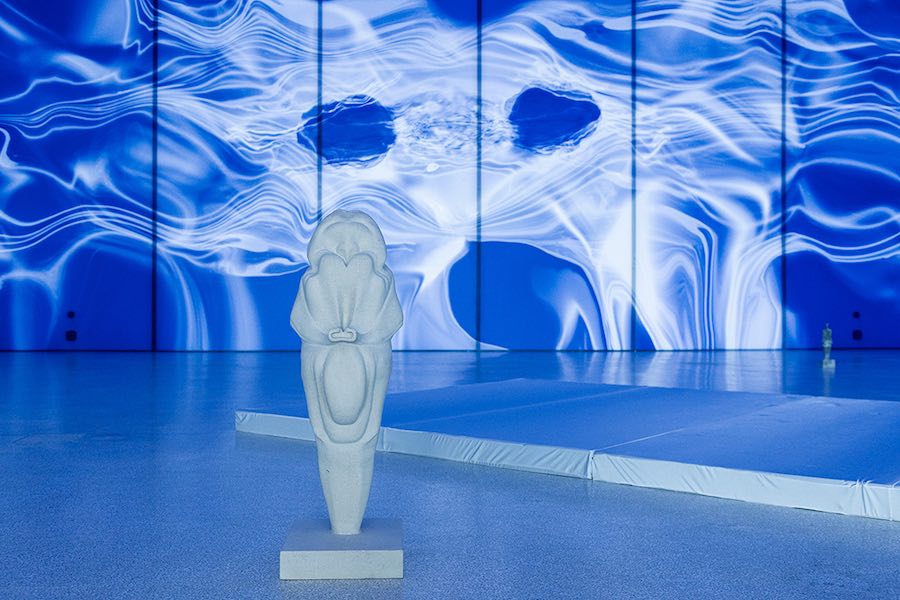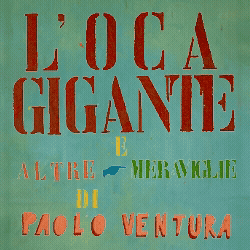
English text below
Il titolo, in una parola, Oscillations, racconta bene il movimento che, costante, scandisce molto parte della ricerca dell’artista francese Margherite Humeau, presenta al Museion con la sua prima personale in un museo italiano. L’artista con le sue opere indaga l’attuale epoca digitale immergendosi nei grandi misteri sedimentati nei secoli, nei paradossi e nelle contraddizioni della storia dell’umanità e nei suoi millenari tentativi di stabilire una connessione con l’universo.
La mostra Oscillations – a cura di Letizia Ragaglia e Frida Carazzato, in corso fino al 26/01/2020 – presenta un gruppo di sculture in bronzo, marmo e pietra e prende le mosse dalla fascinazione e il mistero intorno alle statuette preistoriche delle veneri, risalenti all’età paleolitica. In particolare l’artista esploragli influssi che le sostanze psicoattive di cervelli animali potrebbero aver avuto sulle forme scultoree delle figure preistoriche delle veneri stesse.
Nell’intervista che segue abbiamo chiesto all’artista di raccontarci cosa lega la mostra Oscillations – terzo atto di una trilogia iniziata al New Museum di New York (Birth Canal, 2018), continuata negli spazi del Kunstverein di Amburgo (Ecstasies, 2019) – agli altri due precedenti progetti. Abbiamo sondato uno degli elementi che da sempre caratterizzano la sua ricerca, il mistero. Enigmi, scoperte, arcani si intrecciano con i temi che l’artista tratta, spesso in relazione con i grandi enigmi dell’umanità. Passato e presente, storia e attualità scorrono in parallelo nelle sue opere, esempi ne siano le Statuette preistoriche delle Veneri, da cui l’artista è partita per raccontare uno suo personalissimo viaggio. Le abbiamo chiesto cosa la affascina di questi reperti.
Tra le tante interpretazioni che aleggiano attorno alle Statuette preistoriche delle Veneri, la Humeau si è confrontata con l’interpretazione dell’antropologa Bethe Hagens che ha stabilito un collegamento tra le figure delle Veneri e la forma del cervello animale. Nella sua teoria sostiene la possibilità che le statuette fossero una sorta di ricette scolpite che simboleggiavano come gli essere umani ingerissero cervelli animali per innescare degli stati di trance (in quanto contenenti sostanze psicoattive). L’artista ci racconta come ha elaborato questa teoria, partendo proprio dalla necessità di mettere in dubbio la genesi stessa delle Statuette: “E se questi artefatti fossero stati creati intenzionalmente per essere ambigui?”
L’artista ci racconta che è stata attirata da ciò che Bethe Hagens ipotizza nelle sue teorie, ossia che qualunque esperienza vissuta attorno a queste Statuette è stata sostanzialmente cultura in quanto quelle che noi chiamiamo in modo riduttivo “Statuette di Venere” in realtà possono essere state delle veri e propri mezzi per viaggi spirituali sciamanici. Mettendo a confronto le statuette con il cervello, si sono rilevate una serie di corrispondenze. Lavorando con antropologi, archeologi, neuroscienziati, biologi, l’artista ha cercato di fare chiarezza sui misteri attorno al mistero di Venere: osservando le statuette come fossero cervelli, sono riusciti a rivelare gli ibridi del cervello animale, notando analogie e somiglianze. Da qui il suo tentativo di progettare “cervelli femminili” che siano da considerare come delle ricette per nuove miscele e pensieri visionari.

Le sculture sono da osservare come il risultato di analogie, scoperte e rivelazioni di questi lunghi studi: donne in via di continue mutazioni; alcune sono molto prossime a dei corpi umano, altre invece, sono diventate animali o cervelli di animali, Altre, infine, sono diventate delle Veneri.
Scavando ulteriormente nelle affascinanti oscurità attorno alle statuette, Humeau ha scoperto che alcuni scienziati ipotizzano che oltre 150.000 anni fa, un gruppo di umano ha casualmente esperito delle sostanze psicoattive; non si sa esattamente in cosa consistessero, funghi, fiori, un suono, cervelli animali. L’aspetto importante di questa scoperta rivela che grazie a questo ‘accidentale’ assunzione di sostanze psicoattive, per la prima volta l’essere umano è entrato in un territorio inesplorato, dando così avvio, a visioni e conoscenze mentale che possono essere state all’origine della lingua, dell’arte e della religione.
Segue l’intervista con l’artista —
Elena Bordignon: This exhibition is the third act of a trilogy which began at the New Museum in New York (Birth Canal, 2018), continued at Hamburg’s Kunstverein (Ecstasies, 2019) and will end with the exhibition Oscillations in Bolzano. Could you tell me why you chose these three titles?
Marguerite Humeau: Birth Canal was the first iteration of this project and it started from an impulse to investigate the Venus figurines more closely and to think of them as the mothers of Humankind – Mitochondrial Eves, if you like. Ecstasies was about connecting these sculptures to my research on primal states of trance and how those early trance states may have been at the origin of language, art and religion. It was about reenacting a speculated primal trance. Oscillations is about connecting the deep past to contemporary research. It is about exploring the prehistoric and contemporary technological means through which transcendence, or at least its conceptual potential, can be achieved.
EB: Mystery is one of the most important elements of your work. Enigmas, discoveries and mysteries are woven together in your artistic research, often in relation to the great enigmas of humanity. Past and present, history and modernity flow simultaneously in your works. The mystery that characterizes the Oscillations exhibition is related to the prehistoric Venus statuettes. Why did you choose this phenomenon for the exhibition? And what interests you about their history?
MH: The Venus figurines is a term given to a collection of prehistoric statuettes of women made during the Paleolithic Period (between 35,000 and 11,000 years ago), mostly found in Europe, but with finds from as far away as Siberia too. To date, more than 200 of the figurines have been found, all of which are portrayed with similar physical attributes, including curvaceous bodies with large breasts, bottoms, abdomen, hips and thighs, and usually tapered at the top and bottom. Considering they were found all over Europe, and sometimes separated by thousands of years, the similarity of these sculptures is extraordinary.
The true meaning and purpose of these Venuses are not known and may never be understood, which prompts us to wonder why prehistoric people separated by considerable time and distance created such similar figures, and what they really meant. Some of the many theories suggest they were fertility symbols, self-portraits, Stone Age dolls, realistic depictions of actual women, ideal representations of female beauty, religious icons, embodiments of spirits, representations of mother goddesses, primitive currencies, or even the equivalent of pornography. Some experts have even speculated on the existence of an early pre-Indo-European matriarchal order that preceded Bronze Age civilisations and was displaced by them.


EB: Among the many interpretations of these prehistoric statuettes you came across is that of the anthropologist, Bethe Hagens, who has established a connection between the figure of Venus and the form of the animal brain. She argues that these statuettes were a sort of sculptured recipe that symbolized how humans ingested animal brains in order to reach a trance-like state (as brains do contain psychoactive substances). How did you develop this theory in relation to the exhibited works? And what interests you about it?
MH: What if these artefacts were intentionally created to be ambiguous? And what if these “women” are “brains”? asks Bette Hagens in her essay “Venuses, turtles, and other hand-held cosmic models”. There is strong evidence that Cro-Magnons ate brains. So, why? It may be because brains contain medicinal and psychoactive substances. Bette Hagens speculates that whatever experiences such substances opened up to ancient people, they were the core of their cultural existence. She states that the objects we have labelled “Venus Figurines” may constitute the remains of an ancient transportation network for shamanic spirit travel. A comparison of Venus figurines with brains reveals a number of correspondences.
Hagens suggests that ancient spiritual technicians may have carved replicas of brains that encoded characteristics of the real or “ideal” animal totem one wished to contact and “become”. A brain replica might not correspond to any particular animal but it could incorporate the relative size and development of the brain parts believed necessary to perform certain physical activities (super smell, visual acuity etc).
Venus figurines, then, would serve not only as a meditative icon – but perhaps as a recipe too. So, the various parts of an animal’s brain may have been copied to produce predictable “spirit travel”. The dynamics of that journey could then be altered and fine-tuned, perhaps with other brain parts, much as we season a stew. Sometime in history this knowledge was then lost.
I have been on a quest to unlock the Venus mysteries. In recent years I have worked with anthropologists, archeologists, neuroscientists, veterinary neurologists, biologists, from around the world, to try to unlock the Venus mysteries. By looking at the Venus figurines as if they were brains, we have succeeded in revealing the animal brain hybrids (rodents, birds, fishes, wolves, etc.) from which some Venuses may have been made. Some of them even look like sick brains (Kuru, Scrapie, Creutzfeldt Jacob, etc), as eating those contaminated brains, being infected and falling ill, may also have been considered a way of embarking on a spiritual journey of sorts.
Using this recently discovered theory, and inspired by the original Venuses, I have designed new “women-brains” that are recipes for new concoctions and visionary thoughts.

The resulting sculptures are women’s bodies at different stages of mutation. Some are still close to human bodies, some have become animals or animal brains, and some have become Venuses.
Following this research, I made further investigations into primal experiences of trance. Some experts have speculated that around 150,000 years ago, a group of humans randomly encountered psychoactive substances for the first time. No one knows what they were: mushrooms, psychoactive flowers, maybe the beat of a drum… or animal brains…? Through this intake of psychoactive substances, for the first time in human history, the brain abandoned its standard way of thinking and entered uncharted territory. The spectacular consequences of this event may have resulted in a neuronal reorganization that was imperceptible because it happened on a microscopic scale. This new configuration of the human brain allowed for a new social structure that was totally different to that of other primates. The urgent need was to testify or mimic these visions, and it has, therefore, been argued that these newly experienced journeys of the mind may have been the origin of language, art, and religion.
EB: In your exhibition there are several works related to sound. Could you explain how you developed the sounds that accompany the exhibition at the Museion and what is their significance?
MH: From soft breathing to repetitive singing, the female figures witnessed here are experiencing a primordial trance. Their voices lead us through the journey of the mind they are engaged with. At times they mutate into different animals and at others they push their human capacities to the limit. I worked with ten female voices and I asked them to reach trance-like states and to mutate into animals or natural elements, such as a forest or storm. Their voices can be heard struggling and reaching the limits of their human abilities. That is when they start mutating. They have to mutate and transcend their own bodies in order to maintain their existence in a different form.
I also worked with one of my close collaborators, Johan Lescure, to spatialize the sound and create a very specific physical experience of it. At a certain point all the voices join together to sing a monotonous sound that triggers a state of trance. They then all seem to be sucked in by a large window/membrane at one end of the space, as if they were suddenly entering a door to the spirit world.
At another time, right at the beginning of their mutation phase, their voices seem to travel through space like spirits or specters. At other times, they are static human bodies. Their presence constantly shifts, from human bodies they become animals or spirits, disembodied souls, but then they come back to their corporeal shell and then they transform again in a never-ending cycle.
Ha collaborato Valentina Bartalesi












